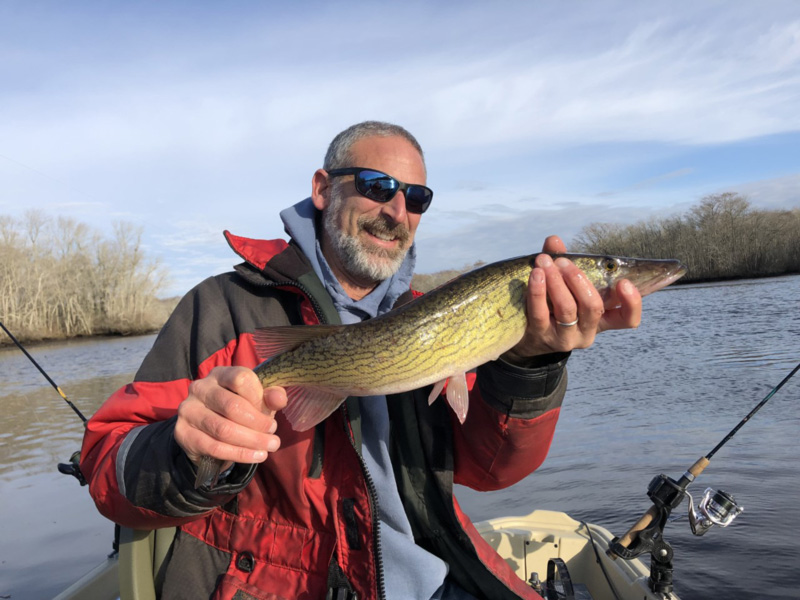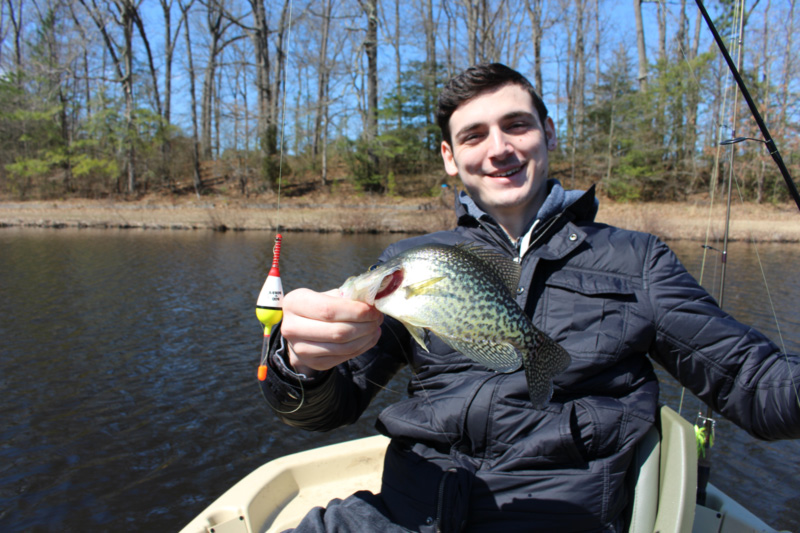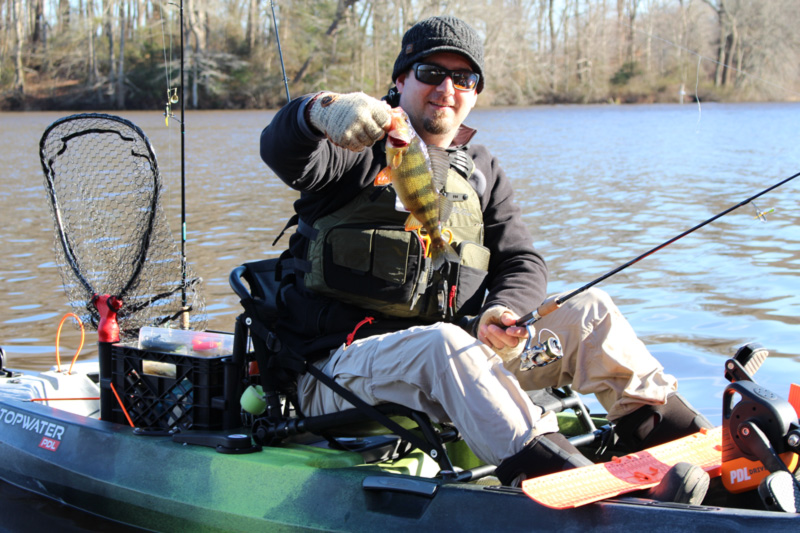Many of us cruise down the DelMarVa peninsula on a regular basis during our fishing endeavors, whether it’s to hit a Chesapeake Bay fishing hotspot or reach the beach for some saltier action. But there’s another angling option we drive past all summer long, which should have us hitting the brakes come winter: the DelMarVa millponds. Well over a dozen millponds are scattered across the shore, and as long as they don’t freeze solid, they offer up some rather spectacular cold weather fishing. We won’t dwell on the individual ponds here, because you can get the low-down on eight specific options in the article Eastern Shore Millponds: Fantastic Freshwater Fishing. We will, however, delve into some of the mysterious aspects of millpond fishing which can leave even the best anglers stumped.

Where Are the Fish?
Due to the unique geography of these bodies of water, fish often won’t be where you expect to find them. Depths rarely exceed eight feet in most millponds and in many cases 90 percent of the water will be just three or four feet deep. Underwater contours are few and far between. And since we’re talking right now about fishing them during a timeframe when it’s quite cold out, the fish are often in search of warm spots.
Many anglers new to millponds go with what they know. They see deadfall along the shoreline and start casting at it. Fair enough. You’ll pull up some bass this way, and on occasion pick up a crappie or a chain pickerel. But this isn’t generally where the bulk of the fish will be found during the cool months of the year. In many cases, locating the remnants of last summer’s weedbeds will make for much better action. Pickerel in particular will be focused in these areas, and since pickerel are a cold-water fish they’ll provide a lot of the action during this portion of the season. Crappie will also be found around any weeds that haven’t died off, and when you find a mix of weeds and stumps, you’re in prime bass territory.
Another form of structure that’s important to probe in the millponds is the stream bed channel. These millponds exist because streams were dammed up to power gristmills. Yes, they are that old, sometimes dating back to the 1700s. (The mill at Leonard’s Pond in Salisbury, MD, for example, is mentioned in accounts from the Revolutionary War as a place where loyalist Torries gathered before the patriot General Smallwood arrived with a regiment of troops). So in each and every one of these ponds there’s a channel ranging from two to four feet deeper than the surrounding waters. In most cases these channels are small and difficult to locate, often being no wider than 10 feet and sometimes just half of that. As one might expect, however, since they’re one of the few geographic anomalies in these ponds, the fish often orient to them.
After the sun has had hours to warm up the pond’s banks, you may find that the fish shift away from these mid-lake forms of structure and towards the shorelines. Remember that the sun rises in the east and tracks through the southern sky through the course of the day, so western and northern shorelines will soak up the most rays. On calm, clear days, in the mid-afternoon, water temperature in a north-western cove can rise two or even three degrees above that of water on the opposite side of the pond. You can bet that the fish living in the millponds are well aware of this phenomenon.

Is it likely to be a win when you find a weedbed remnant that abuts the streambed channel with a stump or two close to a north-western shoreline? You can do the math.
Millpond Fishing Tactics
Once you find that likely looking spot, how will you fish it? You can cast any of the usual slew of offerings like spinnerbaits for bass, tube jigs for crappie, and wobbling spoons for pickerel. Put in your time, and you will catch fish. During the winter months, however, it’s exceedingly tough to beat the effectiveness of live bait. A kicking, wiggling minnow which you can present to the fish at a crawl will out-catch lures the vast majority of the time, regardless of which species you’re targeting.
For pickerel and bass, the bigger the minnow the better. For crappie smaller offerings generally work best. In some of the ponds you’ll also pick up a bonus yellow perch here and there regardless of the minnow’s size. How you fish the minnow, however, differs by the species you’re after.
- Crappie – This species tends to like a very slow presentation in the winter months, so suspending the minnow under a bobber and working it at a creep is the ticket. Tie a small shad dart or marabou jig on the end of four- to six-pound test line — crappie get line-shy when they’re moving this slowly and anything heavier may go untouched — and let it dangle two to three feet down under the float. Remember that crappie will often play with a bait for quite a while before really taking it, and if you see the bobber jiggle and dance, hold back. Don’t set the hook until that float is completely submerged, or moving sideways across the water’s surface at a good clip. Also note that crappie will often abandon a bait if the bobber is tough to pull down, so stick with thin quill bobbers or the smallest round bobber possible.
- Largemouth Bass – Put a live baitfish into the water in any format, and if a bass sees it when in a mood to feed there’s an excellent chance it’ll snap it up. That said, they’re often willing to go after a faster moving meal than crappie, and casting and retrieving lets you cover a lot more water in short order as opposed to drifting a bobber. So many bass anglers will put a minnow behind a bare jighead or a hair jig and work it through likely looking areas one after the next.
- Pickerel – As with bass, when a hungry pickerel spots a live minnow, the minnow’s days are likely numbered regardless of presentation. You will catch more pickerel, however, if you keep the bait moving as opposed to sitting static. When there’s a bit of a breeze, drifting along with a bobber and minnow is a good bet. When the air is calm, slow-trolling the minnow becomes a more effective tactic. There will also be times when, for whatever reason, the added vibration of a twirling blade is what it takes to trigger strikes. So if you’re not catching it’s a good idea to try putting one of those minnow onto the hook of a Road Runner, and either cast and retrieve it or slowly troll it along.

Interestingly, each of these millponds seems to have its own unique character. Wye Mills Lake is known for having acres of gorgeous-looking territory that’s barren, and a few isolated hotspots that hold densely-packed schools of fish. Johnson’s Pond has frustrated countless anglers with an unpredictable bite that’s either red hot or utterly dead. Schumaker Pond is a favorite of anglers who don’t have boats, thanks to extensive shoreline access at Schumaker Pond Park. Yet while each is different in its own way, these bodies of water all share one common trait that goes beyond history and geography: each offers wintertime anglers an excellent shot at success. Whether you’re after crappie for the frying pan or bass for the selfie, now’s a great time to head for the DelMarVa millponds.